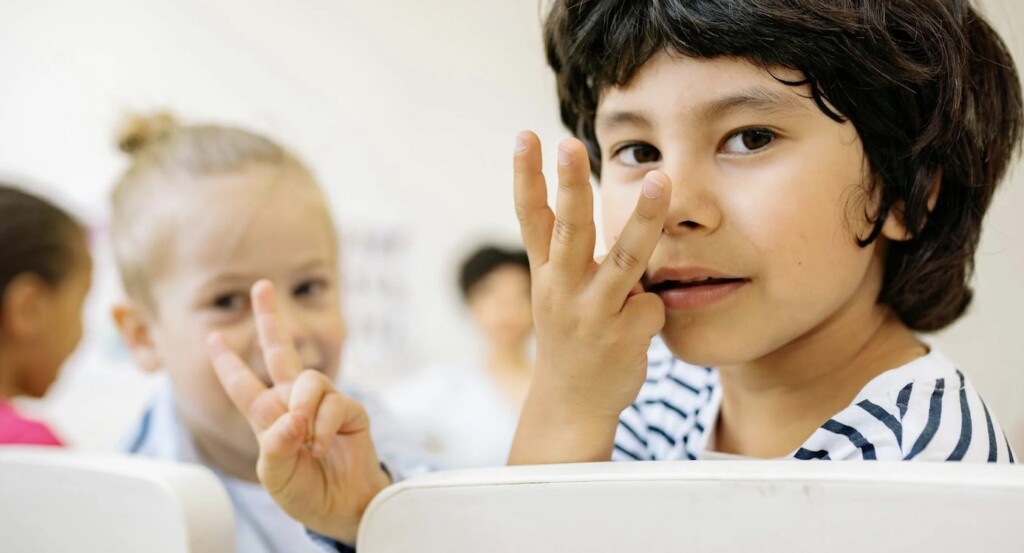Counting on Fingers Really Helps Kids Improve Their Math Skills–By 40% New Study Shows

Some teachers consider finger counting a signal that youngsters are struggling with math, while others associate its use as advanced numerical knowledge.
Now, new research is the first to show that children’s performance in arithmetic can show a “huge” improvement through the teaching of a finger-counting method.
Swiss and French teams explored whether finger counting can help primary-school-aged children to solve math problems. They said adults rarely use their fingers to calculate a small sum, because such behavior could be attributed to cognitive impairments or “pathological difficulties” in math.
But young children under age 8 who use their fingers to solve such problems may be seen as intelligent, probably because they have already reached a level that allows them to understand that a quantity can be represented by different means.
The research aimed to determine whether children who don’t count on their fingers can be trained to do so, and whether such training would result in enhanced arithmetic performance.
The study, published in the journal Child Development, focused on 328 five- and six-year-old children at kindergarten, mainly living in France, and tested their abilities to solve simple addition problems.
The kindergarteners were recruited through their teachers, who voluntarily took part in the experiment, which included a pre-test, training held over two weeks, a post-test closely after the training’s end, and a delayed post-test.
The results showed an “important increase” in performance between pre- and post-test for the trained children who did not count on their fingers originally—from 37% to 77% of correct responses—compared to non-finger users in the control group.
MORE MATH TIPS TO IMPROVE SCORES:
• Children Do Much Better in Math When Music is Added to the Lesson: New Study
• Boy Struggling at School is Now Math Genius After Mom Taught Him to Use an ABACUS
Whether children who use finger counting are using it as an arithmetic procedure or understand something deeper about numbers will still need to be determined with future research.
“Our findings are highly valuable because, for the first time, we provide a concrete answer to the long-standing question of whether teachers should explicitly teach children to use their fingers for solving addition problems,” said study leader Dr. Catherine Thevenot.
“Finger calculation training is effective for over 75% of kindergartners,” she added. “The next step is to explore how we can support the remaining 25% of children who didn’t respond as well to the intervention.”
Dr. Thevenot, of the Institute of Psychology at the University of Lausanne, Switzerland, says the study came about as a result of conversations with primary school teachers.
“They often asked me whether they should encourage or discourage children from using their fingers to solve calculations.
“Surprisingly, the existing research didn’t offer a clear answer, which left teachers understandably frustrated with my frequent response of ‘I don’t know.’
“This recurring question, coupled with the lack of concrete evidence, inspired me to investigate the issue myself.
“When I first saw the results, I was amazed by the huge improvement in performance among children who didn’t initially use their fingers to solve the problems.
MOST FUN MATH:
• The Mind-Blowing Mathematics of Sunflowers
• The Beautiful Mathematics of a Snowflake
“Before our intervention, these children were only able to solve about one-third of the addition problems during a pre-test. After training, however, they were solving over three-quarters of them.
“This improvement truly exceeded my expectations,” said Dr. Thevenot. “The difference was striking, especially compared to the control groups, where gains were insignificant.
“An important question now is to determine whether what we taught to children goes beyond a mere procedure to solve the problems.
“In other words, we want to know whether our intervention led to a deeper conceptual understanding of numbers, specifically whether children better grasp how to manipulate the quantities represented by their fingers.
WATCH: Math Teacher Impresses Students With The Most Genius April Fools Prank
“In fact, we have already started addressing this question and the initial results are very promising. However, we still need to carry out additional experiments to confirm that these improvements are indeed a direct result of our training program.”
1..2..3..GO! SHARE the Fascinating Study With Parents on Social Media…
>read more at © GoodNews
Views: 5